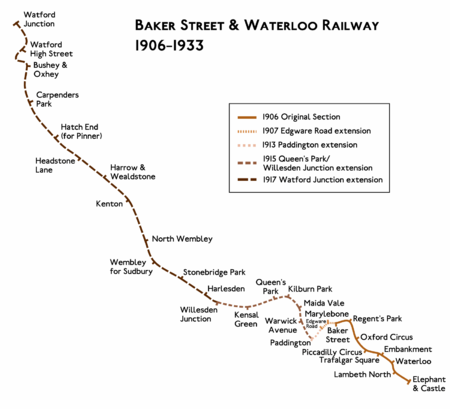
Back Baker Street and Waterloo Railway ID ベーカーストリート・アンド・ウォータールー鉄道 Japanese Baker Street & Waterloo Railway Portuguese

The Baker Street and Waterloo Railway (BS&WR), also known as the Bakerloo tube, was a railway company established in 1893 that built a deep-level underground "tube" railway in London.[a] The company struggled to fund the work, and construction did not begin until 1898. In 1900, work was hit by the financial collapse of its parent company, the London & Globe Finance Corporation, through the fraud of Whitaker Wright, its main shareholder. In 1902, the BS&WR became a subsidiary of the Underground Electric Railways Company of London (UERL) controlled by American financier Charles Yerkes. The UERL quickly raised the funds, mainly from foreign investors.
When first opened in 1906, the BS&WR's line served nine stations and ran completely underground in a pair of tunnels for 6 kilometres (4 miles) between its northern terminus at Baker Street and its southern terminus at Elephant and Castle with a depot on a short spur nearby at London Road.[1] Extensions between 1907 and 1913 took the northern end of the line to the terminus of the Great Western Railway (GWR) at Paddington. Between 1915 and 1917, it was further extended to Queen's Park, where it came to the surface and connected with the London and North Western Railway (LNWR), and to Watford; a total distance of 33 kilometres (21 miles).[1]
Within the first year of opening it became apparent to the management and investors that the estimated passenger numbers for the BS&WR and the other UERL lines were over-optimistic. Despite improved integration and cooperation with the other tube railways and the later extensions, the BS&WR struggled financially. In 1933, the BS&WR was taken into public ownership along with the UERL. Today, the BS&WR's tunnels and stations operate as the London Underground's Bakerloo line.
Cite error: There are <ref group=lower-alpha> tags or {{efn}} templates on this page, but the references will not show without a {{reflist|group=lower-alpha}} template or {{notelist}} template (see the help page).